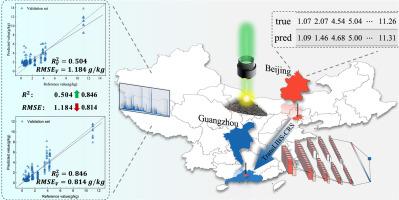TransLIBS-CRS: Integrating LIBS with transfer learning for accurate cross-regional soil total nitrogen detection
IF 5.7
Q1 AGRICULTURAL ENGINEERING
引用次数: 0
Abstract
Accurate detection of soil total nitrogen (TN) is crucial for enhancing crop growth and quality. However, soil variability across different regions limits the generalization ability of calibration models. To address this challenge, this study introduces a model named transfer-learning-assisted laser-induced breakdown spectroscopy for cross-regional soil analysis (TransLIBS-CRS), specifically designed to mitigate the low cross-domain prediction accuracy caused by variations in regional soil properties. By fine-tuning with a limited number of target domain samples, this method significantly improves the cross-domain applicability of LIBS data, alleviating the challenges associated with the difficulty of obtaining soil samples from diverse regions. In the task of predicting TN in Guangzhou using the Beijing dataset, the TransLIBS-CRS model achieved optimal performance, with of 0.846 and RMSEV- of 0.814 g/kg. Further analysis through saliency map and chemometric methods revealed that spectral lines of carbon at 193.0 nm and 247.8 nm play a key role in the quantitative detection of TN. Notably, these spectral features also demonstrated stable predictive contributions when transferred to the Guangzhou soil dataset. This approach offers a feasible solution for large-scale and efficient soil TN detection.

TransLIBS-CRS:将LIBS与迁移学习相结合,实现准确的跨区域土壤全氮检测
土壤全氮(TN)的准确检测对提高作物生长和品质至关重要。然而,不同区域土壤的差异限制了定标模型的泛化能力。为了解决这一挑战,本研究引入了一种名为迁移学习辅助激光诱导击穿光谱的跨区域土壤分析模型(TransLIBS-CRS),专门用于缓解区域土壤性质变化导致的低跨域预测精度。该方法通过对有限的目标域样本进行微调,显著提高了LIBS数据的跨域适用性,缓解了不同地区土壤样本难以获取的挑战。在利用北京数据预测广州地区TN的任务中,translib - crs模型的RV2值为0.846,RMSEV-值为0.814 g/kg。通过显著性图和化学计量学方法进一步分析发现,193.0 nm和247.8 nm碳谱线在TN定量检测中发挥了关键作用,这些光谱特征在广州土壤数据集中也表现出稳定的预测贡献。该方法为大规模、高效的土壤全氮检测提供了可行的解决方案。
本文章由计算机程序翻译,如有差异,请以英文原文为准。
求助全文
约1分钟内获得全文
求助全文

 求助内容:
求助内容: 应助结果提醒方式:
应助结果提醒方式:


